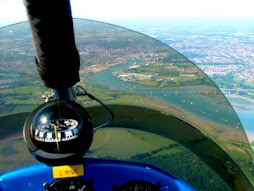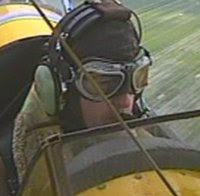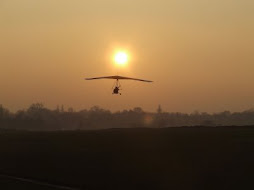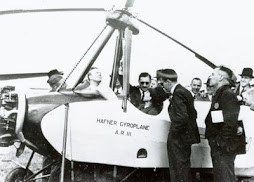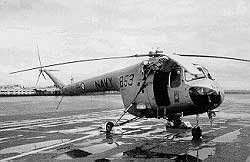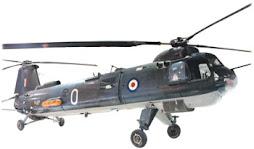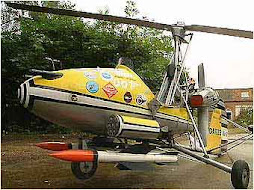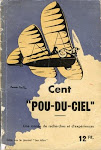Thursday 29 October 2009
"sector recce"
Yesterday I did my "sector recce", which Steve (ex-RAF navigator in Tornados) tells me is the RAF jargon for having a look around the area you are going to be flying in for a while. Being airborne again was fantastic, though no sooner was I up than I realised I needed to land, as my breather tube, normally retained in a hole in one of the panels (which I had decided to fly without), was blowing about and had been unceremoniously shortened by the prop. Damn. Steve realised I was in trouble and came back and landed behind me, though by the time he was down, I had taped the breather out of the way and was ready to take off again.
I flew in an open-face motorbike helmet (with scooter visor). Until now I have always used my Microavionics one, but then I have had the use of a school headset. I need to get myself one. I'd wondered how noisy it would be. But really it was fine. A friend has been trying to convince me of the merits of a Flycom helmet, which cuts out loads of noise and cold but I have to say that these are not necessarily advantages. It is good feeling the air on your face and hearing your engine. I don't want to feel detached from the experience.
I had my balloonist's altimeter in my see-through pocket and it appeared to work rather well. Steve appeared always to be higher than me, though this may be an illusion. The rate of climb is conservative, to the say the least, but I realised pretty soon that I tend to pull on speed, thus losing height or reducing my rate of climb. The trim position is actually a fair stretch. What I need is a vario/vsi (I nearly got an old one on ebay last night)
It was wonderful settling down into the experience of the flight and taking in the sights, circling to enjoy the details, like when I turned quite tightly to look at a church tower near Ickworth house and to return the wave of children on a half-term outing. The House itself looked fantastic from the air and made me feel that if I spend my time sightseeing from my Dragonfly, I need never go abroad again. There is so much to see here...and possibly no better way to see the country than from above. The layout of gardens and vineyards, avenues of trees etc is impossible to appreciate at ground level.
One thing I will HAVE to do is find a way to rig a camera, ideally with a screen to give a field of view...or some kind of wire frame sight....so that I can record what I see. One thing that can be recorded is the route. I think my Etrex can already be made to do this - I haven't explored it yet - but Steve sent me a Google map overlay of our route, as recorded by his own GPS system. It would be terrific to be able to keep a record of every route flown.
A highlight of the flight was a recce of RAF Honington. Steve got us permission to fly in close and have a really good look at the runway. I gather that the base is only now used for NBC training and at one point I saw a gaggle of airmen looking up from the door of what to this amateur looked like a bomb shelter, but which may well have been a gas hut like the one I trained in when I was in the TA. We had to walk around in the CS gas, and take turns at taking masks off and giving name, rank and number before exiting the building, coughing our guts out, our eyes streaming. I remember that I hadn't been issued my army number yet, so I just gave my phone number.
Being now free to fly into the area of the former MATZ will be excellent - though Lakenheath is still out of bounds. We had to keep a keen look-out because there were a number of KC130s flying in at about 500' above us. I had thought it would only be possible to fly beneath the panhandles, but providing we take account of those Lakenheath aircraft, we are a lot more free to fly North of Rougham now that the RAF have stopped ops at Honington.
My landing at the end of the flight was sweet....a darn sight better than my earlier one, which had been very pendulous - very hairy indeed. I think I am going to really enjoy flying my "sector", operating from Rougham....and venturing out further afield.
I talked to some of the chaps flying radio controlled models back at Rougham and one, Kevin, told me about two Tornados he had seen beating up the airfield at about 200'! I am going to have to be on the look-out for that sort of thing, and with that in mind, I MUST get my radio licence. Let me know, folks, if you hear of an affordable radio. I am planning on not bothering with an interface, just using an OPC499 with a GA headset, or similar rig.
Yesterday was an important landmark for me. From now on I am an independent operator. Free to fly.
I flew in an open-face motorbike helmet (with scooter visor). Until now I have always used my Microavionics one, but then I have had the use of a school headset. I need to get myself one. I'd wondered how noisy it would be. But really it was fine. A friend has been trying to convince me of the merits of a Flycom helmet, which cuts out loads of noise and cold but I have to say that these are not necessarily advantages. It is good feeling the air on your face and hearing your engine. I don't want to feel detached from the experience.
I had my balloonist's altimeter in my see-through pocket and it appeared to work rather well. Steve appeared always to be higher than me, though this may be an illusion. The rate of climb is conservative, to the say the least, but I realised pretty soon that I tend to pull on speed, thus losing height or reducing my rate of climb. The trim position is actually a fair stretch. What I need is a vario/vsi (I nearly got an old one on ebay last night)
It was wonderful settling down into the experience of the flight and taking in the sights, circling to enjoy the details, like when I turned quite tightly to look at a church tower near Ickworth house and to return the wave of children on a half-term outing. The House itself looked fantastic from the air and made me feel that if I spend my time sightseeing from my Dragonfly, I need never go abroad again. There is so much to see here...and possibly no better way to see the country than from above. The layout of gardens and vineyards, avenues of trees etc is impossible to appreciate at ground level.
One thing I will HAVE to do is find a way to rig a camera, ideally with a screen to give a field of view...or some kind of wire frame sight....so that I can record what I see. One thing that can be recorded is the route. I think my Etrex can already be made to do this - I haven't explored it yet - but Steve sent me a Google map overlay of our route, as recorded by his own GPS system. It would be terrific to be able to keep a record of every route flown.
A highlight of the flight was a recce of RAF Honington. Steve got us permission to fly in close and have a really good look at the runway. I gather that the base is only now used for NBC training and at one point I saw a gaggle of airmen looking up from the door of what to this amateur looked like a bomb shelter, but which may well have been a gas hut like the one I trained in when I was in the TA. We had to walk around in the CS gas, and take turns at taking masks off and giving name, rank and number before exiting the building, coughing our guts out, our eyes streaming. I remember that I hadn't been issued my army number yet, so I just gave my phone number.
Being now free to fly into the area of the former MATZ will be excellent - though Lakenheath is still out of bounds. We had to keep a keen look-out because there were a number of KC130s flying in at about 500' above us. I had thought it would only be possible to fly beneath the panhandles, but providing we take account of those Lakenheath aircraft, we are a lot more free to fly North of Rougham now that the RAF have stopped ops at Honington.
My landing at the end of the flight was sweet....a darn sight better than my earlier one, which had been very pendulous - very hairy indeed. I think I am going to really enjoy flying my "sector", operating from Rougham....and venturing out further afield.
I talked to some of the chaps flying radio controlled models back at Rougham and one, Kevin, told me about two Tornados he had seen beating up the airfield at about 200'! I am going to have to be on the look-out for that sort of thing, and with that in mind, I MUST get my radio licence. Let me know, folks, if you hear of an affordable radio. I am planning on not bothering with an interface, just using an OPC499 with a GA headset, or similar rig.
Yesterday was an important landmark for me. From now on I am an independent operator. Free to fly.
rigging and de-rigging solo


 I have no pics of the flying itself (must do something about that in future) but it was glorious (why do the most expressive adjectives sound so old fashioned?)
I have no pics of the flying itself (must do something about that in future) but it was glorious (why do the most expressive adjectives sound so old fashioned?) While I was unloading, Steve crept up behind me in his Dragonfly. I was amazed that, whether because I was just too involved in getting organised or was up wind of him (noise, not smell, lol), I didn't hear him taxying, let alone land.
My wing outrigger (for loading and unloading solo) works brilliantly. I did most of my rigging myself, insisting that Steve didn't make it easy for me (though I did ask him to do a few battens, just to speed things up); and once we had landed after our "sector recce" and said our goodbyes, I was de-rigging solo for the first time and very much aware that nobody was going to bail me out if it went wrong. So I was delighted that I packed my wing away very tidily indeed.....and got it up on to the van roof-rack with ease.
 de-rigging with nobody to bail me out if I got into trouble
de-rigging with nobody to bail me out if I got into troubleI took lots of pictures of the trike and of the narrow gauge undercarriage. The day before I'd made a gizmo for keeping the ramps parallel too, and was pleased that it seemed to work ok.

the trike before the narrow gauge wheels are put on

Both sets together, before the wider set is retracted for transit

lifting narrow gauge wheels onto trolley raises undercarriage off ground

retract main gear

dispense with trolley

 load up.
load up.(the narrow gauge wheels fit the trike in the van and will run it through my front door, where the trolley makes it manoeuvrable -sideways etc- indoors, where space is restricted)
Sunday 25 October 2009
Repairs done
Yesterday I made parallel spacers for my ramps, so that I don't have to keep tweaking them when running the trike up and down them, recharged the battery and refitted it (though my local motor parts specialist had never even heard of locking wire!), re-stuck the plastic inside the monopole splint and cleaned up the holes on the monopole and splint so that the two bolts slide in more easily. I guess I am ready to test everything.
But I have been looking at the weather and the wind is up. I reckon Tuesday looks best for a test flight.
But I have been looking at the weather and the wind is up. I reckon Tuesday looks best for a test flight.
Saturday 24 October 2009
varifocals
Other exciting news is that I now have varifocal glasses, making it possible to see both at a distance (I am short sighted) and read a map on my lap. Young eyes are able to change shape enabling them to adjust for both short and long distance, but in your mid forties, typically, the eye hardens and makes this adjustment difficult, so that while I have used the same prescription for ten years for reading as for driving (and everything else), recently I have noticed that it has been easier to take my specs off for reading....and that has made it very difficult indeed to read a map while flying. Hopefully varifocals will make both possible.
For anyone unfamiliar with these things, you look through the middle and upper parts of the lense to see middle and long distance, and through the lower part of the lens for reading. Getting used to them typically takes a couple of weeks, but luckily my prescription isn't too bad, so I am already getting used to them.
For flying on bright days I also have varifocal shades which look very cool indeed...with head hugger stems, making it easy to slip them under a helmet or headphones.
For anyone unfamiliar with these things, you look through the middle and upper parts of the lense to see middle and long distance, and through the lower part of the lens for reading. Getting used to them typically takes a couple of weeks, but luckily my prescription isn't too bad, so I am already getting used to them.
For flying on bright days I also have varifocal shades which look very cool indeed...with head hugger stems, making it easy to slip them under a helmet or headphones.
Starting a Bailey engine after it has stood for some time
Ben wrote back to my worried enquiry about my starting problems, and his advice was very helpful indeed. I followed it up with a call about charging my battery and that too very much reassured me. He is very clear that when in doubt, he is happy for people to ask.
I hope he won't mind me quoting him, because I think this could help others:
"Starting the engine after leaving the engine for a few weeks:
1) No throttle, throttle closed.
2) Turn engine over and keep it turning to pump up the fuel. This may take up to a minute if the fuel bowl in the carburettor is empty. Once the fuel bowl fills the engine will fire.
3) If the engine does not start after turning over for up to a minute. Leave alone for at least 2 - 3 minutes, the generated vacuum in the crank case and fuel system will draw up the fuel. Now try to start and she should fire almost immediately.
4) Do not use any throttle until the engine fires, the automatic choke is on full at this point and any throttle will simply flood the engine and prevent firing.
5) If engine fires and stops, open the throttle by a small amount (10%) and she will fire.
Pissing in the wind is better than 5 second bursts, the initial rotation of the engine requires huge power from the battery and repeating this will flatten the battery very quickly, make sure the battery is fully charged before starting, charge at home if you haven't been running the engine for a long time.
Try to start the engine and run it for a minute or two every couple of weeks, this will keep the fuel line and fuel bowl primed and help start the engine first swing. "
It all makes perfect sense. Short bursts just drain the battery. Ben said that the initial load on the battery is actually, for a microsecond, greater than the fuse rate, but it is so short a burst that the fuse doesn't blow....but if the process is repeated over and over, it is bound to deplete the battery, especially as it hadn't been charged after standing for a few months.
So, this afternoon I need to snip my securing wires on my battery connectors and get that battery on charge while I find someone local who sells locking wire. I reckon I will get loaded up to fly tomorrow, when hopefully the weather will be better.
Thank you, Ben
I have just heard back from Cath at Flylight, too, confirming my payment for a front strut protector; they now have them in red :) again, and for an F1 funnel, which is the type she uses on her Dragonfly and which she says fits the Dragonfly well. The great thing about these funnels is that they are designed to filter out water caused by condensation in fuel tanks.
Thanks Cath.
I hope he won't mind me quoting him, because I think this could help others:
"Starting the engine after leaving the engine for a few weeks:
1) No throttle, throttle closed.
2) Turn engine over and keep it turning to pump up the fuel. This may take up to a minute if the fuel bowl in the carburettor is empty. Once the fuel bowl fills the engine will fire.
3) If the engine does not start after turning over for up to a minute. Leave alone for at least 2 - 3 minutes, the generated vacuum in the crank case and fuel system will draw up the fuel. Now try to start and she should fire almost immediately.
4) Do not use any throttle until the engine fires, the automatic choke is on full at this point and any throttle will simply flood the engine and prevent firing.
5) If engine fires and stops, open the throttle by a small amount (10%) and she will fire.
Pissing in the wind is better than 5 second bursts, the initial rotation of the engine requires huge power from the battery and repeating this will flatten the battery very quickly, make sure the battery is fully charged before starting, charge at home if you haven't been running the engine for a long time.
Try to start the engine and run it for a minute or two every couple of weeks, this will keep the fuel line and fuel bowl primed and help start the engine first swing. "
It all makes perfect sense. Short bursts just drain the battery. Ben said that the initial load on the battery is actually, for a microsecond, greater than the fuse rate, but it is so short a burst that the fuse doesn't blow....but if the process is repeated over and over, it is bound to deplete the battery, especially as it hadn't been charged after standing for a few months.
So, this afternoon I need to snip my securing wires on my battery connectors and get that battery on charge while I find someone local who sells locking wire. I reckon I will get loaded up to fly tomorrow, when hopefully the weather will be better.
Thank you, Ben
I have just heard back from Cath at Flylight, too, confirming my payment for a front strut protector; they now have them in red :) again, and for an F1 funnel, which is the type she uses on her Dragonfly and which she says fits the Dragonfly well. The great thing about these funnels is that they are designed to filter out water caused by condensation in fuel tanks.
Thanks Cath.
Sunday 18 October 2009
Frustration
 Compass pillar slots neatly into the hole-saw cut hole in the binnacle and is secured with velcro. This places the compass low so that the rear digits can be read easily and, unlike other solutions I have seen, cannot be bumped by the speed bar.
Compass pillar slots neatly into the hole-saw cut hole in the binnacle and is secured with velcro. This places the compass low so that the rear digits can be read easily and, unlike other solutions I have seen, cannot be bumped by the speed bar.
 The outrigger bar performed well today, enabling me to load the wing single-handed at the airfield, though Steve did help me get it to the car, which I think might be easier if I made a skid or golf-trolley type affair.
The outrigger bar performed well today, enabling me to load the wing single-handed at the airfield, though Steve did help me get it to the car, which I think might be easier if I made a skid or golf-trolley type affair. and felt ready.
Loading up today (including erecting the roof rack), took over an hour, though I was grateful for a hand from my neighbour, David, in lifting my wing on to the roof of the van. I had an uneventful trip to Rougham, where the gate was opened by an aeromodeller and where another told me my mate was waiting and asked if I'd call up on Rougham Radio to let them know when I was taking off, so that they could ground their models first.
I met Steve and then discovered that he had turned out, just home from a trip, not intending to fly, himself. I'd imagined that he was going to be rigging his Dragonfly too. Very generously, he came just to help me, though he would also say that it gave him the chance to try out a half-tension rigging, which we concluded was not really easier and which created its own problems; we had to de-batten 8 and 9 to release sufficient tension to be able to locate cam cups over the wands; I found camming-over a lot easier today, both on half tension and no-tension; and tensioning at the keel (in both modes) was a lot easier today, too, which bodes well for the future.
But lifting the wing so that the monopole located was murder and Steve is adamant that it is a process which is best suited to hangar rigging. He watched and was very unhappy with the twisting that he observed in the plates either side of the monopole. Eventually we got it rigged, but only after a bit of surgery on the plastic sandwich, which had become rucked in the process. This is a bit worrying for me....
...but not as much so as the fact that I couldn't get the engine to start. The simple fact is, we later discovered, the filter was dry. I tried and tried to start until my battery was out of juice. I am guessing this is down to that fuel pump problem which Ben designed the modification to deal with. I have never encountered a problem with mine, but before I try anything else, I shall do the mod (and recharge the battery) and try to start it again.
This is the second week in a row that my plans to fly have been frustrated. Last week my van failed its MOT, now sorted. This week engine problems.
Damn.
Huge thanks to Steve for turning out and sticking with me through it all. Ah well, I expect I have learned quite a lot anyway and my rigging times are bound to be improving. Tell you what though, I can see why Steve has dispensed with body panels. I think life would be a lot easier without them. For pragmatic reasons, I reckon I will leave them at home next week.
Sunday 11 October 2009
a wheelchair ramp provides a compact, lightweight solution
 I didn't like my ladder-based ramp. It was heavy, clumsy...and got me teased relentlessly at Sywell ;)
I didn't like my ladder-based ramp. It was heavy, clumsy...and got me teased relentlessly at Sywell ;)So I decided to either make, have made or buy something more compact . . . and found this on ebay: a portable wheelchair ramp, capable of carrying 28 stone...and designed to be carried by taxis, etc. I have played with it, but as my van is currently at the garage, I haven't had the chance to actually try the ramp out properly.
It is a nice little design made from aluminium extrusion, which telescopes in three stages from 28" to 5' (which is a bit shorter than my own ramp, but which I think will be fine) and has a grippy, sandpaper-like running surface. It comes in its own, conveniently designed zip-up canvas bag, compact enough to put in the seat-well too; better than having to go to the trouble of securing a ramp to the roof-rack and having to check the straps at every service station.
£44 including postage.

.
Monday 5 October 2009
red check
The mobile tower at Rougham is provided in the form of a truck (with a collapsing chassis) known affectionately as the "ice-cream van", but carries a stern warning not to ask for ice-cream. Spot the clue that it was not kept busy on the 3rd, when it was blowing a gale outside.

In by-gone years, this caravan (below) did the same job at another airfield before being purchased by Rougham's owner, Sir John Agnew, who I haven't met yet, but who is very much a man of the people and a great aviation enthusiast. It is down to his attitude to flying that I am allowed to fly at Rougham.

This weekend it doubled as a hangar for Felix's model aeroplane. It is rather cosy, with a bunk on one side, storage space, a hatch at the top of a ladder and a swivel chair poking up into a cloche-style tower, about as roomy as the cockpit of a Messerschmitt 109

I clambered up into it and saw that albeit cramped, it gave a good view of the field and I think it would be great if it was used more. It is a beautiful bit of kit.


Sunday 4 October 2009
Wing rigging and de-rigging with Steve
This afternoon, in a quiet period at Rougham, after Steve had already spent a long and very busy day marshalling well over 100 aeroplanes, he very kindly came across the main runway to a quiet spot to meet me and Lizzie, who I had brought rather than the trike, to take me through the entire procedure for rigging and de-rigging my wing. (more about this later)
Afterwards, we considered the tricky business of loading a wing onto a roof-rack and experimented with an idea I saw on YouTube, which kayakists and canoeists use, where you stick an outrigger out from your rack, which you prop one end of the wing or boat on, then lift the other end on to the rack. It worked rather well (using a metal stake we found in a barn) and was considerably simpler than a roller mechanism I welded up in the workshop this morning.
Co-incidentally, Jeremy suggested the very same solution this evening! Here is his link . Many thanks Jeremy - great minds think alike!
Thank you, Steve, for the excellent instruction (and for the check-list), and Lizzie for helping me unload when I got home.
Afterwards, we considered the tricky business of loading a wing onto a roof-rack and experimented with an idea I saw on YouTube, which kayakists and canoeists use, where you stick an outrigger out from your rack, which you prop one end of the wing or boat on, then lift the other end on to the rack. It worked rather well (using a metal stake we found in a barn) and was considerably simpler than a roller mechanism I welded up in the workshop this morning.
Co-incidentally, Jeremy suggested the very same solution this evening! Here is his link . Many thanks Jeremy - great minds think alike!
Thank you, Steve, for the excellent instruction (and for the check-list), and Lizzie for helping me unload when I got home.
Saturday 3 October 2009
Dambuster pilot


Steve Wilson gave me my Rougham air-side marshalling induction today, though there was no opportunity to put it into practice, as with enormously strong winds blowing all day, we only saw a gyrocopter and a Yak 52, both of which were marshalled by Steve and Felix.
A highlight of the afternoon, however, was decanting a large tanker lorry into a bowser, simply under atmospheric pressure....by moving the bowser to lower ground behind an ex-RAF airfield tractor, formerly property of 617 Squadron of Dambusters fame.
Peter Eager (famous airshow commentator) radioed up to say that it was wanted over the other side of the airfield, so as Felix had his car to take back, he asked me to do the honours with the bowser, and naturally I was delighted. However, it was a bugger to get in gear and what I initially thought was first, turned out to be third, but as it was very torquey indeed, it still happily pulled away and but for a very hard ride (murder on any erk's back), was quite fun to drive. The funny thing is that all the pedals are on the right of the gearbox, so you have to sit off-set on it.
Tomorrow, when the afternoon is quiet, Steve and I are going to practise rigging and derigging my wing. Today, he and I drove around the runways so that I could see the layout, as this will be my flying base.
A highlight of the afternoon, however, was decanting a large tanker lorry into a bowser, simply under atmospheric pressure....by moving the bowser to lower ground behind an ex-RAF airfield tractor, formerly property of 617 Squadron of Dambusters fame.
Peter Eager (famous airshow commentator) radioed up to say that it was wanted over the other side of the airfield, so as Felix had his car to take back, he asked me to do the honours with the bowser, and naturally I was delighted. However, it was a bugger to get in gear and what I initially thought was first, turned out to be third, but as it was very torquey indeed, it still happily pulled away and but for a very hard ride (murder on any erk's back), was quite fun to drive. The funny thing is that all the pedals are on the right of the gearbox, so you have to sit off-set on it.
Tomorrow, when the afternoon is quiet, Steve and I are going to practise rigging and derigging my wing. Today, he and I drove around the runways so that I could see the layout, as this will be my flying base.


a post-war ground crew of 72 Sqn on a David Brown tractor.
Friday 2 October 2009
Air Vice Marshal ;)
I get trained up by Steve Wilson to be an air-side marshal tomorrow at Rougham. Marshalling at three events per year is the small price I shall pay in future for being able to fly without limitations from the airfield; in point of fact, being air-side is a privilege, so it really is a win-win situation. And what's more, Steve is a Dragonflyer, so tomorrow I get to pick his brains about flying our type.
And on Sunday he is going to give me a run-through of the wing assembly and disassembly process. I have been through the disassembly once before, with Stewart Bond, but that was some time ago and frankly no amount of refreshing in this area can be a bad thing.
Should be a good weekend!
And on Sunday he is going to give me a run-through of the wing assembly and disassembly process. I have been through the disassembly once before, with Stewart Bond, but that was some time ago and frankly no amount of refreshing in this area can be a bad thing.
Should be a good weekend!
Subscribe to:
Posts (Atom)











